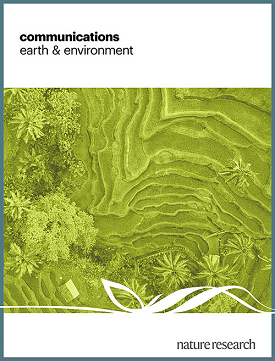日益严重的干旱对全球陆地表面构成威胁
IF 8.9
1区 地球科学
Q1 ENVIRONMENTAL SCIENCES
引用次数: 0
摘要
全球变暖影响了水循环,但目前还没有在全球尺度上对植物可利用水分影响的全球研究。这里,来自欧洲中期天气预报中心数据集的云优化月度汇总气候再分析表明,从1960年到2023年,全球27.9%的陆地表面变得明显更加干旱,而20.5%的陆地表面变得明显不那么干旱。其中,湿润、半湿润和半干旱地区面积分别减少851、145和53万km²,干旱和超干旱地区面积分别增加634和418万km²。干旱地区总共增加了999万平方公里,占全球陆地面积的5.9%,不包括格陵兰岛和南极洲。在已经干旱的地区,如北美西南部、巴西北部、欧洲盆地、北非、中东、萨赫勒和中亚,加速干旱化已经发生,其中中非是一个新的热点。主要驱动因素是由于大气温度上升,潜在蒸散量相对于降雨量不成比例地增加,这也降低了土地的碳汇能力,可能加剧气候变暖。ERA5-land月度汇总气候再分析数据显示,1960 - 2023年,全球27.9%的陆地表面干旱程度加重,20.5%的陆地表面干旱程度减轻,导致干旱区面积增加5.9%,这与土地碳汇容量减少和气候变暖有关。本文章由计算机程序翻译,如有差异,请以英文原文为准。

Growing aridity poses threats to global land surface
Global warming has impacted water cycle, but not exist a global study of the changes at global scale of the impacts on water available for plants. Here, cloud-optimized monthly aggregated climate reanalysis from the European Centre for Medium-Range Weather Forecasts dataset indicates that from 1960 to 2023, 27.9% of the global land surface became significantly more arid, while 20.5% became significantly less arid. This indicates a shift towards drier climates, with humid, semi-humid, and semi-arid areas decreasing by 8.51, 1.45, and 0.53 million-km², respectively, and arid and hyper-arid areas increasing by 6.34 and 4.18 million-km², respectively. This total increase of 9.99 million km² in arid areas represents 5.9% of the global land surface, excluding Greenland and Antarctica. Accelerated aridification has occurred in already dry regions, such as South-west North-America, North-Brazil, the European-Basin, North-Africa, the Middle-East, the Sahel, and central-Asia, with central-Africa as a new hotspot. The main driver is the disproportionate increase in potential evapotranspiration relative to rainfall, attributed to rising atmospheric temperatures, which also reduces the land’s carbon sink capacity, potentially exacerbating climate warming. From 1960 to 2023, 27.9% of the global land surface became more arid, while 20.5% became less arid, resulting in a 5.9% increase in arid regions, linked to reduction of land’s carbon sink capacity and climate warming, according to analysis of the ERA5-land monthly aggregated climate reanalysis dataset.
求助全文
通过发布文献求助,成功后即可免费获取论文全文。
去求助
来源期刊

Communications Earth & Environment
Earth and Planetary Sciences-General Earth and Planetary Sciences
CiteScore
8.60
自引率
2.50%
发文量
269
审稿时长
26 weeks
期刊介绍:
Communications Earth & Environment is an open access journal from Nature Portfolio publishing high-quality research, reviews and commentary in all areas of the Earth, environmental and planetary sciences. Research papers published by the journal represent significant advances that bring new insight to a specialized area in Earth science, planetary science or environmental science.
Communications Earth & Environment has a 2-year impact factor of 7.9 (2022 Journal Citation Reports®). Articles published in the journal in 2022 were downloaded 1,412,858 times. Median time from submission to the first editorial decision is 8 days.
 求助内容:
求助内容: 应助结果提醒方式:
应助结果提醒方式:


